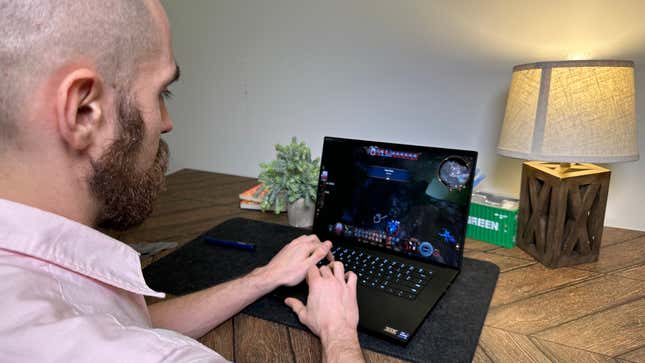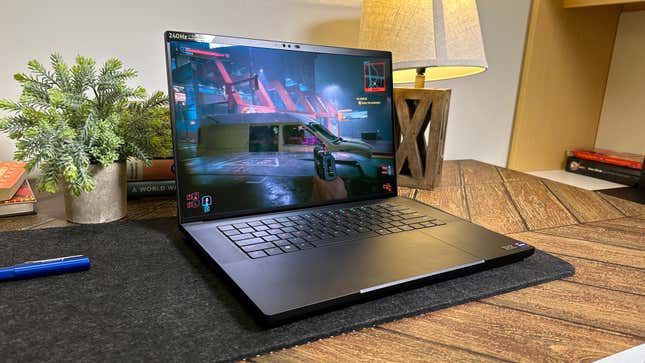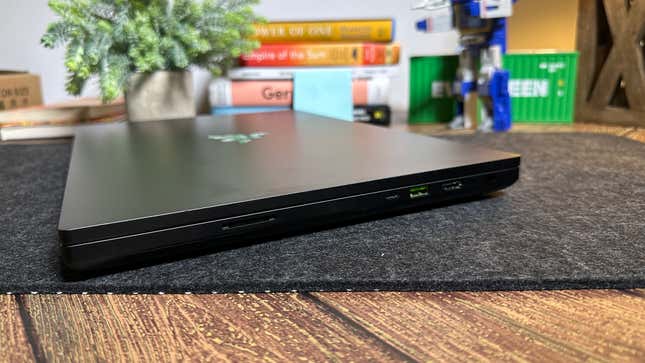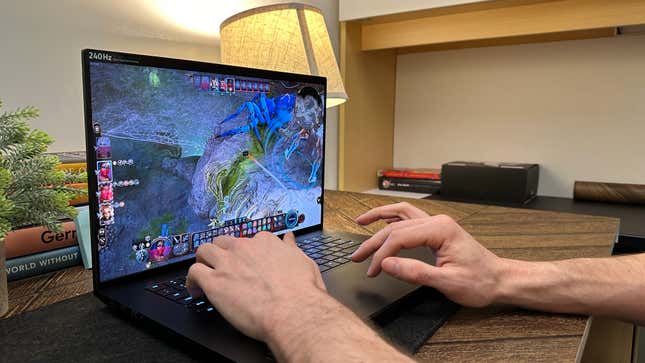Razer Blade 16
A beautiful new OLED screen puts one of the best gaming laptops over the edge, but it still needs some refinement.
The Blade 16 is Razer’s latest refresh to what’s been the gaming laptop to get if you don’t want to trade performance for portability. With a slightly better CPU, a Nvidia GeForce RTX 4090, and a beautiful OLED with 240Hz refresh rates, it’s the prettiest and most capable the 16-inch Blade has ever been, though it’s also its most expensive to date. Starting at $3,000 (Reviewed at $4,200)
Pros
The screen is beautiful with ultra-competitive refresh rates
It’s as powerful as ever, and it can play the most demanding games with ease
The laptop gets hot, but the cooling is good enough that it’s never truly uncomfortable
Cons
The notoriously pricey laptops is now more expensive than ever
The charging cable can cover up a few ports
The keyboard and trackpad are still not up to snuff
The Razer Blade 16, long the north star of gaming laptops emphasizing portability and power, is prettier (and far more expensive) than ever before. This latest laptop refresh also makes it clear that Razer is keen to sit back on its bed of laurels, and that’s not necessarily good news for somebody like me who wants to get the most out of a laptop that costs more than twice my monthly salary.
The real reason you would drop upwards of $3,000 on the 2024 edition of the Razer Blade 16 over other high-end gaming laptops is because of the new screen. Razer’s delivered a quality OLED screen capable of running games at a 240 Hz refresh rate, all in a form factor that still fits inside my backpack’s laptop sleeve. There’s a real sense of John Hammond from Jurassic Park saying “spared no expense” feeling to such a powerful laptop, and it’s clear at this point that Razer has parked itself well at the head of most other ultra-high-end gaming laptops, and it’s refusing to come down off its perch.
The latest Blade 16 doesn’t need to make any real concessions in both portability and power, especially compared to its massive 18-inch sibling older sibling from 2023 and the new 2024 version of the Blade 14, which contains an AMD Ryzen 9 CPU and up to a Nvidia RTX 4070 compared to the 16-inch’s Intel Ci9 HX series processor and up to a Nvidia RTX 4090 GPU. The Blade 16 is also one of the most expensive gaming laptops, starting at $3,000 for a slightly less capable RTX 4070 version. That’s $400 more than the current MSRP starting price of last year’s cheapest Blade 16, and it’s all to do with the slightly improved processor and the frankly beautiful, blisteringly fast OLED display.
But Razer also hasn’t done enough to improve some simple quality-of-life issues that keep me from offering my full-throated endorsement. Most hardcore gamers with their own bespoke mouse and keyboard setups won’t mind that the Razer’s trackpad and keys are subpar compared to the rest of the device–but damn me if I still do.
Why nitpick? Because the Razer Blade is a very, very expensive device. You get desktop-level performance plus, now a full capital “G” gamer-level display, and all on a laptop device, but it will still run you several thousand dollars for that privilege. At the low end of just under $3,000, you still get the quality 240 Hz OLED and an RTX 4070. That would probably be good enough for most users. Still, at the top end, with an incredible 8 TB of SSD storage and 96 GB of DDR5 memory, the most expensive Blade 16 crushes wallets with a whopping $5,499 price tag. Razer is still as premium as always, but does the perfect gaming laptop exist? No, unfortunately, not yet.
Razer Blade 16 Screen Quality
This is the Reason to Buy the 2024 Razer Blade 16 Over Past, Cheaper Models

In just the first few months of this year, we’ve seen PC- and display-makers placing extra emphasis on refresh rates. The field is now crowded with OLED monitors boasting at least 240 Hz, if not more. Razer has accomplished something pretty damn significant, offering customers the possibility of 240 Hz refresh rates on a QHD+ resolution OLED display.
This new 240 Hz OLED is the Blade 16’s main selling point–practically the only reason you would buy this version of the 16-inch laptop over the last generation. No, it’s not a full 4K, but it’s still OLED, and for folks like me, that’s enough. You go for OLED for the beautiful color contrast and deep blacks. That’s all here.
For some, the refresh rate is what grabs their attention first. The 240 Hz has been standardized for some competitive gaming environments that demand twitch-levels of precision. If that’s important to you, then yes, the Blade 16 lives up to your expectations. It has a .2 m/s response time and 400 nits of peak brightness. This feels as luxurious as a laptop screen can get without being 4K.
Razer hailed that the screen is VESA-certified ClearMR 11000 at the full 240 Hz, meaning there won’t be any unnecessary motion blur despite the fast refresh rates. I did not notice any blurring or screen hiccups in my hours spent with the Blade 16.
A few other configurations, including the most expensive ones that cost upwards of $5,000, have variable refresh rates and resolutions. The most expensive also isn’t OLED, but mLED, and since I haven’t seen that in person, I can’t speak to its overall quality compared to the standard, organic light-emitting diode version.
Razer Blade 16 Performance
As Fast as You Could Want Before it Turns Into a Rocket and Flies Away

Gizmodo previously cited the Blade 16 as the pinnacle of gaming laptops for a good reason. The newest Blade is again a powerhouse among gaming PCs. No, you’re probably not surprised to hear that with the top-end graphics card inside the Blade 16, you’ll play some extremely demanding games with few issues.
My version of the Blade 16 with the GeForce RTX 4090 is a beast, plain and simple. You would expect it to be at its $4,200 price point. Most laptop versions come with 32 GB of DDR5 memory and the 14th Ven Intel Core i9 14900Hx processor, but my version also comes with 2 TB of SSD storage, just in case you want to pack your entire Steam library on just one computer.
Demanding titles like Cyberpunk 2077 require you to crank up the performance settings as high as they can to max out framerates with ray tracing enabled. If you want everything put to max, you’ll still need to turn on Nvidia’s AI upscaler DLSS, which doubled framerates in Cyberpunk so that I could hit above 80 FPS with every setting turned up to 11.
I personally don’t like hearing the sound of fans blasting while I game, so inevitably, you’ll have to limit device performance to keep things as cool as possible. For that, DLSS is also rather nice on slightly less demanding games. Warhammer 40K: Darktide can easily hit 60 FPS on the highest settings with the Blade 16. With DLSS, I can hit well over 150 with ray tracing features enabled, and that reading was taken when I had the laptop on automatic settings. Frame hunting has never been easier with today’s current generation of AI-enhanced graphics options, but it’s still a shame you have to pay so high a price even to have the option.
Other benchmarks put it above last year’s Blade 16, which also sported a mobile RTX 4090 at the top end and an Intel Core i9-13950H, but only marginally. Thanks to the new CPU, the 2024 edition scores about a few hundred points better than the last-gen. It did much better against last year’s CPU-focused tests, like in Geekbench 6 and Cinebench, but you could already expect that considering the bump.
The Blade 16 may not have an edge over other ultra-high-end laptops just based on pure CPU benchmarks. Our tests showed that the MacBook Pro with an M3 Max chip may beat the Blade 16 on Geekbench’s CPU benchmark. Of course, The MacBook can’t yet be called a true gaming laptop, at least not until Apple finds it within itself to get more developers to support its infrastructure. Still, it’s barely any more powerful than it was with the previous gen’s Intel Core i9-13950HX. It’s a similar story across a whole lot of benchmark tools.
Simply put, the 2024 Blade 16 refresh is not much more capable than last year’s extremely powerful and extremely expensive laptop, and that’s a shame because I would have hoped Razer could have modified a few of the bare usability issues that were there last year as well.
Razer Blade 16 Battery Life and Build Quality
It’s Still Very Portable Despite the Weight

Razer has again shown why its spartan-style laptop design is best in the field. It’s a full CNC-milled aluminum design that feels premium to hold. We’ve compared the Razer Blade to the MacBook Pro before. If you’ve previously held one of Apple’s ultra-premium laptops, you’ll have a general sense of the Razer’s extremely sturdy build quality.
Despite how much power is packed into its shell, Razer has still managed to keep the overall size down. It’s certainly not the thinnest laptop out there at .86 inches, but the nearly-14 14-inch width was just small enough to fit inside several laptop sleeves of the backpacks I own. You’d be surprised how many 16-inch laptops fail at that simple task. That being said, it’s still a hefty device to carry around. It weighs about 5.4 pounds so that you won’t be frisbeeing it easily across the room. Don’t forget the absolutely rather large power brick you’ll need to schlep around. Razer claims the charger is 60% smaller than other 330 W chargers, but the brick with its braided cable will occupy a big space in your backpack no matter how big a bag you have.
And just like any gaming laptop, don’t expect you’ll manage to keep it going for very long. It’s a 95.2 Whr battery, but that’s not going to tide you over for even half a day of non-intensive use. During an average workday, I managed about 4 hours just using the default settings on browser-only tasks. When gaming, expect about two hours on a full charge before you need to plug it in again. That was on the recommended “Balanced” performance mode and limiting the monitor to a 60 Hz refresh rate, which automatically takes effect if you don’t have it hooked up to an outlet.
This laptop wants to remain hooked to a physical power source, but know that the device can get rather warm rather quickly as it guzzles its juice ration. During a late-night session with friends, I could feel the part of the device closest to the charging port getting uncomfortably warm. Under stress, I registered the shell around the power connector at 108 degrees Fahrenheit. Note that that’s perfectly fine for most laptops, and that wasn’t on the maximum fan settings when the Blade’s blades were going so fast it sounded like the laptop was about to hover in the air like a drone.
Razer has again boasted that it has expanded the Blade 16 vapor chamber cooling system and ultra-thin exhaust fins. It’s a big laptop with a lot of power stuffed inside its shell, so you can’t expect a comfortably cool PC under extreme stress. For what it’s worth, the heat never became a problem that strained in-game performance or put extra stress on the system, which is the most important thing on a gaming laptop.
At the very least, the fan system isn’t overly loud on automatic settings. However, I needed to go into the Razer Synapse settings to manually adjust the fan speed for a little bit extra cooling when my WASD fingers started getting a little too toasty during a Warhammer 40K: Darktide.
You’ll need to use Razer’s charging cable with its proprietary, though reversible port and the utterly massive 330W power brick to get power to your PC. Depending on how you orient the cable affects how easily you can access the left side’s two USB Type A, single USB-C, and headphone jack. The right side includes another USB-A, a HDMI 2.1 slot, and another USB-C. There’s also the full SD Card reader, which should be expected on a PC of this scale.
Razer Blade 16 Keyboard and Trackpad
Please, for the Love of All That’s Holy, Fix the Palm Rejection on the Trackpad

There’s little to complain about with the Razer Blade 16 with its performance or screen, but I find it most baffling that a laptop of this price and scale is how the makers still haven’t confronted the quality of its controls, meaning the keyboard and trackpad.
The RBG lighting under the Blade 16’s keys is rather subtle, especially compared to other gaming laptops I’ve used. They’re not overly bright; depending on the game, they should automatically light up with the most common controls. However, without fine-tuning, the full spectrum of keybindings won’t show up, so I would be left feeling strangely indelicate when I’m actively using keys that the laptop decided not to give any active glow to. You can customize everything through the Chroma Studio in Razer Synapse if you want to start a rave every time you log in for your next session of The Finals.
Yet, it’s still using the same chiclet keyboard as previous generations. They’re relatively recessed and wide keys that aren’t going to result in many issues when you’re gaming on the go, but it’s not the sort of quality I expect from a top-of-the-line laptop.
What annoys me most about using the Razer Blade 16 for anything other than gaming is its massive touchpad. Typing can get annoying as I’ll accidentally click on the pad and start retyping wherever I leave my cursor. That lack of palm rejection is far better on other laptops from this year, such as the recently reviewed MSI Prestige 16. It was a problem on past Razers that’s still present today.
Should You Buy a Razer 16 Blade?
Of course, most people will use a mouse with their Razer, but if you’re paying upwards of $4,000 for a gaming laptop, you should expect more. I typed my review on the Blade 16, and my coworkers could hear me constantly curse under my breath as I would accidentally click on another area of the page and start typing where I didn’t mean to.
This is a very expensive laptop, and Razer has been very considerate in most other areas of its design, especially the new screen. Sometimes, the little things count, and with the Razer being more expensive than ever, we need to be more critical than we have before.

